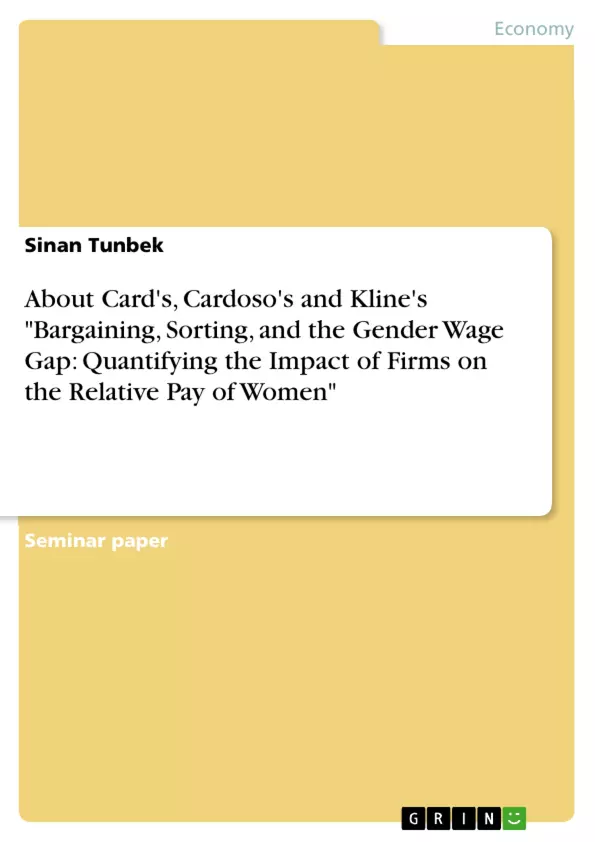Since the main focus of this seminar is on female labor supply the relative wage of women is an important factor. Over the past 100 years women labor force participation increased sharply and women are often even higher educated than men. Despite these facts there is still a huge wage gap between female and male workers in virtually all developed countries. Equal access to jobs and equal treatment within a firm by gender is guaranteed by legislation in most of the developed economies, still firms pay female and male workers differently.
The bargaining and sorting effect may contribute to these differences. The former effect suggests that women may negotiate less aggressively than men and therefore receive a smaller share of the surplus generated by their job. The latter effect suggests that women tend to move to lower-paying jobs. Since there was no comprehensive economic research of both strands the underlying Card et al. provides the first comprehensive analysis of the impact of firm-specific pay premiums on the gender wage gap.
Inhaltsverzeichnis (Table of Contents)
- Introduction
- Institutional Setting and Data Overview
- Modeling Framework
- Exogeneity
- Normalization
- Decomposition of the Firm Specific Pay Premium
- Descriptive Evidence for Exogeneity and Restrictive Assumptions
- Estimation Results
- Impact of Occupation
- Decomposition of the Pay Premium Based on Firm Effects
- Within Firm Changes in Profitability and Wages
- Conclusion, Shortcomings, Open Questions and Possible Extensions
- References
- Figures and Tables
Zielsetzung und Themenschwerpunkte (Objectives and Key Themes)
The primary objective of this paper is to examine the impact of firm-specific pay premiums on the gender wage gap. This research seeks to quantify the influence of bargaining and sorting effects on the relative pay of women compared to men. It aims to understand how these effects contribute to the persistent gender wage gap observed in developed economies.
- The impact of firm-specific pay premiums on the gender wage gap.
- The relative influence of bargaining and sorting effects on women's wages.
- The role of firms in shaping the gender wage gap.
- The significance of firm-specific factors in determining worker compensation.
- The implications of the findings for policies aimed at reducing the gender wage gap.
Zusammenfassung der Kapitel (Chapter Summaries)
- Introduction: The paper introduces the research question of how firm-specific pay premiums contribute to the gender wage gap. It highlights the importance of the topic and the relevance of the study to understand the persistence of gender wage disparities despite legislative efforts towards gender equality. The introduction also provides a brief overview of the existing literature and the theoretical framework employed in the study.
- Institutional Setting and Data Overview: This chapter discusses the institutional context of the study, which is Portugal, and the data set utilized. The authors argue that the Portuguese setting provides a suitable context for examining the gender wage gap due to specific characteristics such as high female labor force participation rates and the availability of comprehensive data. The chapter also presents descriptive statistics on the gender wage gap in Portugal, worker characteristics, and job mobility patterns.
- Modeling Framework: This chapter delves into the econometric model used to analyze the impact of firm-specific pay premiums. The authors present a rent-sharing model that incorporates factors such as alternative wages, match surplus, and gender-specific share of surplus. The chapter explains the decomposition of the match surplus into different components and the rationale for including worker and employer fixed effects in the model.
- Descriptive Evidence for Exogeneity and Restrictive Assumptions: This chapter provides evidence for the exogeneity of firm effects, a crucial assumption in the model. It examines non-parametric evidence by comparing wage changes for men and women moving between matched firms. This section demonstrates the plausibility of the exogeneity assumption and addresses potential biases associated with the model.
- Estimation Results: This chapter presents the main estimation results from the model. It analyzes the impact of firm-specific pay premiums on the gender wage gap and decomposes the effects into bargaining and sorting channels. The chapter also explores the relationship between firm-specific wage premiums and measured productivity, using firm value-added as a proxy.
- Impact of Occupation: This chapter examines the influence of occupation on the gender wage gap and the role of firm-specific pay premiums in contributing to occupational segregation. It analyzes whether the observed patterns hold across different occupations and explores the potential implications for the overall gender wage gap.
- Decomposition of the Pay Premium Based on Firm Effects: This chapter further investigates the decomposition of the pay premium into bargaining and sorting effects, taking into account the impact of firm characteristics. It examines how firm-specific factors contribute to the gender wage gap within different types of firms and provides insights into the relative importance of bargaining and sorting effects across firms.
- Within Firm Changes in Profitability and Wages: This chapter analyzes the relationship between changes in firm profitability and wage changes for men and women within the same firms. It explores whether firms with increasing profitability tend to increase wages more for men or women, shedding light on the dynamics of gender wage differences within firms over time.
Schlüsselwörter (Keywords)
This research paper primarily focuses on the gender wage gap, firm-specific pay premiums, bargaining effects, sorting effects, rent-sharing model, worker-firm data, firm value-added, and occupational segregation. These concepts are central to understanding the drivers of gender wage disparities and the role of firms in shaping the relative compensation of women compared to men.
- Citar trabajo
- Sinan Tunbek (Autor), 2016, About Card's, Cardoso's and Kline's "Bargaining, Sorting, and the Gender Wage Gap: Quantifying the Impact of Firms on the Relative Pay of Women", Múnich, GRIN Verlag, https://www.grin.com/document/471030



